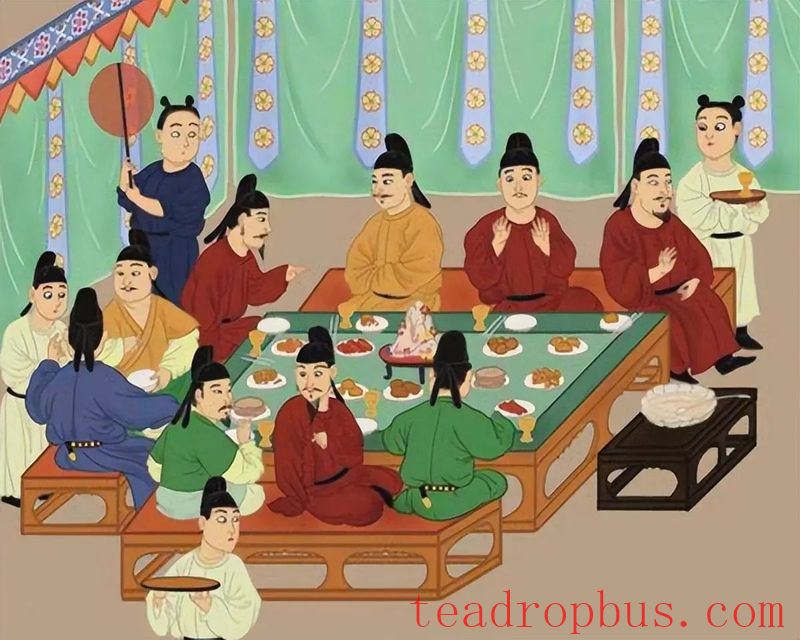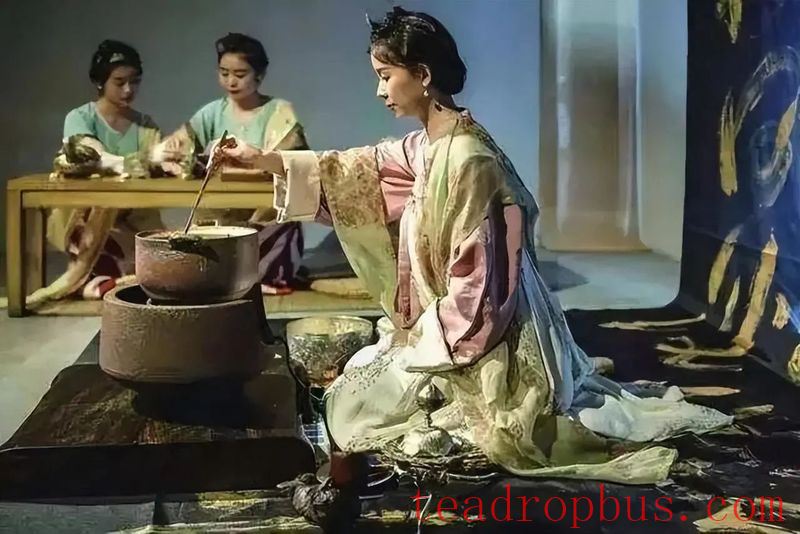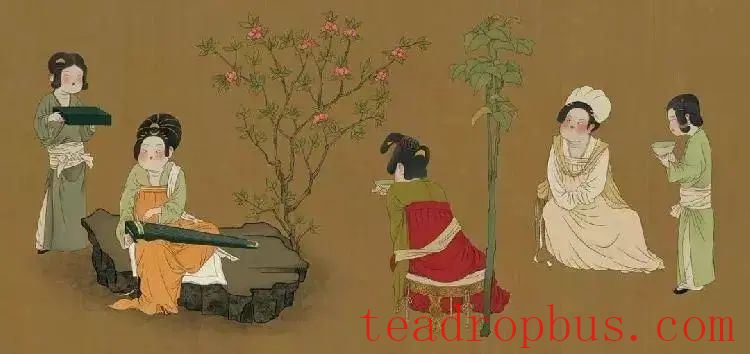
Nowadays, there are mainly two ways of Drinking Tea: plain brewing and mixed brewing. In the public's mind, mixed brewing is a modern invention, and ancient people always drank plain Tea. However, this is not the case, as ancient people had already experimented with mixed brewing.
Tea was first used for its medicinal properties, then for food. The “Guangya” from the Three Kingdoms period records that in the areas between Jing and Ba, “leaves were collected to make cakes… If you drink it, first roast the cakes until they turn red, then grind them into powder and place it in a ceramic vessel. Pour boiling water over it and mix it with scallions, ginger, and tangerine peels. Drinking it helps to sober up and keeps you awake.” This describes mixing tea with ingredients like scallions, ginger, tangerines, mint, etc., and cooking it into a porridge-like consistency.
Porridge and broth have been popular since the Shang and Zhou dynasties, all the way through the Qin and Han dynasties. People in Northwest China during the Qin and Han dynasties enjoyed meat, so the “tea porridge” that helped digestion and reduced greasiness was widely welcomed. Imagine a bowl of mutton soup, seasoned with tea, and a steaming hot bowl of mutton bubble bread… no, mutton tea is ready. During the Three Kingdoms and earlier, tea was still used for cooking, and people regarded it as a special seasoning. It was not until the Wei and Jin dynasties that tea gradually became a beverage and entered the historical stage.
So how did ancient people mix their tea? The editor has specifically combed through ancient texts to find several ancient mixed brewing methods recorded in these texts. Let's take a look!

Tea + Scallion + Ginger + Jujube + Dogwood + Mint
The “Tea Classic” by Lu Yu records: “… or using scallions, ginger, jujubes, orange peels, dogwood, mint, etc., boil them together, or stir until smooth, or remove the foam while boiling. These are just ditch water, yet customs persist. Alas!” Boiling tea with scallions, ginger, jujubes, orange peels, dogwood, mint, etc., or stirring the tea until it becomes smoother, or removing the foam while boiling.
However, the tea brewed with these methods was, in Lu Yu's opinion, undrinkable, like wastewater poured into a ditch, and not good at all.
Tea + Ginger + Cinnamon + Tangerine + Jujube
In the “Art and Literature Biography,” cited in “The Tea Classic (Part Seven),” it says: “Shandao Kai of Dunhuang was unafraid of cold and heat, often swallowing small stones. The medicines he took had the scent of pine, cinnamon, and honey, and he only drank ‘cha-su' tea.” During the Eastern Jin Dynasty, Shandao Kai of Dunhuang was unafraid of cold and heat, often swallowing small stones. He frequently consumed medicinal pills with the fragrance of pine, cinnamon, and honey, and drank a concoction called “cha-su” made by boiling tea, ginger, cinnamon, tangerines, jujubes, and other ingredients. It is said that Shandao Kai relied on these things to practice in seclusion for seven years and could achieve staying awake day and night and walking over seven hundred miles a day. He passed away at the age of one hundred in Mount Luofu, Guangdong.
But after all, this is just a legend, and should not be taken seriously. No matter how much tea you drink, you cannot skip meals.
Tea + Butter + Sichuan Pepper
“The Biography of Li Yehou's Family”: Prince Fengjie, the grandson of the emperor, loved poetry. At first, when brewing tea, he added butter and Sichuan pepper, and gave some to Li Bi, asking him for a poem. Li Bi playfully composed: “Whipped froth turns into a jade-green pool, adding butter disperses the eyes of glass.” Prince Fengjie later became Emperor Dezong.

The “Biography of Li Yehou's Family” by Li Fan of the Tang Dynasty records: Prince Fengjie, the grandson of the emperor, loved poetry. At first, when brewing tea, he added butter and Sichuan pepper, and gave some to Li Bi, asking him for a poem. Li Bi playfully composed: “Whipped froth turns into a jade-green pool, adding butter disperses the eyes of glass.”
The combination of tea and butter easily brings to mind the well-known butter tea, but adding Sichuan pepper, which has a numbing sensation, makes one wonder if it would taste good.
Tea + Scallion + Ginger + Tangerine
The “Guangya” says: “In the areas between Jing and Ba, leaves were collected to make cakes. For older leaves, the cakes were made with rice paste. If you want to brew tea, first roast the cakes until they turn red, then grind them into powder and place them in a ceramic vessel. Pour boiling water over it and mix it with scallions, ginger, and tangerine peels. Drinking it helps to sober up and keeps you awake.”
In the Jing and Ba areas, tea leaves were collected to make tea cakes. For older leaves, the cakes were made with the addition of rice paste. When you want to brew tea, first roast the cakes until they turn red, then grind them into powder and place them in a ceramic vessel. Pour boiling water over it. Optionally, add some scallions, ginger, and tangerine peels and let them soak. Drinking it can help you sober up and keep you awake and alert. Tea lovers who enjoy alcohol might want to try it, though it is uncertain if the effect is really that good.
Tea + Sichuan Pepper + Ginger + Cinnamon
In “The Book of the Barbarians” by Fan Kuò of the Tang Dynasty, it is recorded: “Tea grows in the mountains around Yingsheng City, scattered and collected without any processing method. The Mengshe tribespeople cooked and drank it with pepper, ginger, and cinnamon.”
According to research, Yingsheng refers to the Yingsheng Commandery of the Nanzhao Kingdom, whose administrative center was located in today's Jingdong County. The tea from Yingsheng City should be a large-leaf variety from Yunnan, also known as Pu'er tea.
They boiled and drank Pu'er tea with Sichuan pepper, ginger, and cinnamon. All three of these are spices with a pungent flavor. Although we have not tasted it, it is estimated that the taste of the tea would not escape the word “spicy.”

The above are some of the ancient mixed brewing methods recorded in ancient texts. Interested tea lovers can try making them to taste the flavors of ancient mixed teas!
If there are any copyright issues, please contact us for removal.